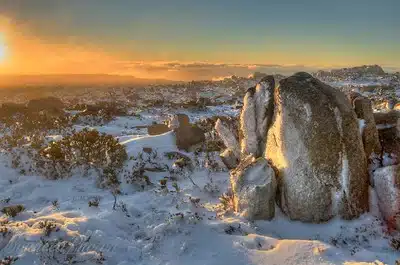Learn Which Parts Get the Most Snow In Australia During the Winter Months
Learn Which Parts Get the Most Snow In Australia During the Winter Months
Blog Article
Recognizing the Importance of Snow in Australia for Farming and Tourism
While Australia is often connected with sun-kissed beaches and arid outback, it likewise boasts a wealth of snowy towering regions. As we investigate this shocking intersection, the possible impact of shifting climate patterns on Australia's snowfall and its subsequent results come to be a compelling focus.

The Unanticipated Snowfall: Australia's Alpine Regions
When winter months cloaks the globe, Australia's Alpine areas wear a white mantle of snow, a spectacle that appears nearly paradoxical in this dominantly sun-baked land. In contrast to the stereotypical photo of Australia as a land of deserts and beaches, these regions use a surprising and gorgeous contrast. The Australian Alps, extending throughout New South Wales, Victoria, and the Australian Capital Territory, get more snowfall than Switzerland. This unanticipated winter heaven supplies a special ecological community, offering a habitat for several indigenous types and a snowy play area for winter months sporting activities lovers. The annual snowfall, although not as bountiful as in some nations, is a crucial aspect of Australia's environment diversity and plays a substantial function in the nation's agricultural practices and tourism sector.
Wintertime's Bounty: Snow's Payment to Australia's Water Resources
In spite of its rarity in the more comprehensive landscape of Australia, snow in the Towering regions plays an important role in the country's water sources. Functioning as a natural tank, the snowpack stores water throughout the cold months, gradually releasing it into rivers and dams as it thaws in warmer seasons. This procedure makes sure a constant supply of water, assisting in the stabilization of the nation's water cycle. This is especially essential for Australia, a continent regularly afflicted by dry spells. Furthermore, the snowmelt feeds right into the Murray-Darling Basin, a lifeline for lots of communities in the southeastern parts of the country. Without the bounty of winter months snow, Australia's water sources would certainly be dramatically stressed, impacting both the population and the setting.
White Blanket, Eco-friendly Area: The Impact of Snow on Australian Farming
Although less noticeable, the influence of snow on Australian farming is significant. Snowfall in the high nation acts as a natural type of irrigation, gradually melting and offering a constant supply of water to lower-lying farmland. This water-rich environment promotes the development of durable plants, adding to the country's farming performance. Snowfall improves soil wellness by introducing wetness and trapping nutrients, which are progressively launched as the snow melts. This procedure improves the dirt, cultivating the growth of healthier, extra resistant plants. Additionally, snow cover works as a protective covering, insulating the ground versus serious winter temperatures that could or else harm plants. Thus, the function of snow in Australian farming is both essential and complex.

Money: Snow Tourism and Its Economic Importance in Australia
While click site the value of snow to Australian farming is usually taken too lightly, its contribution to the country's tourism field is undoubtedly substantial. The snow-laden optimals of Australia's alpine regions draw in a flurry of tourists every wintertime, contributing millions to the national economic situation. Hence, the economic value of snow tourist in Australia extends much past the slopes.
Future Forecast: Environment Modification and Its Possible Results on Australia's Snowfall
As the globe comes to grips with the fact of environment change, so as well should Australia contemplate its potential effects on the country's his comment is here snowfall. Existing clinical models forecast a reduction in Australian snowfall, with potentially severe effects on both agriculture and tourism. In some areas, the snow period can be shortened by approximately 80 days by 2050. Such modifications threaten the practicality of Australia's ski sector, which contributes substantially to the regional economic climate. Less snowfall can also affect the nation's agricultural sector, as snowmelt plays a crucial duty in sprinkling crops. The potential effects of these modifications underline the seriousness of environment my review here modification reduction efforts, both in Australia and around the world.
Final Thought
In verdict, snow is a critical aspect of Australia's farming and tourist markets. The impending threat of climate modification raises worries regarding the future of Australia's snowfall patterns, possibly interrupting these considerable economic fields.

When winter months capes the globe, Australia's Alpine regions wear a white mantle of snow, a phenomenon that seems nearly paradoxical in this dominantly sun-baked land.Regardless of its rarity in the wider landscape of Australia, snow in the Towering areas plays a vital function in the country's water resources. Without the bounty of winter season snow, Australia's water sources would be considerably strained, influencing both the population and the environment.
Hence, the financial value of snow tourism in Australia prolongs far beyond the inclines.
In final thought, snow is a pivotal component of Australia's farming and tourist sectors. Does Australia Get Snow.
Report this page